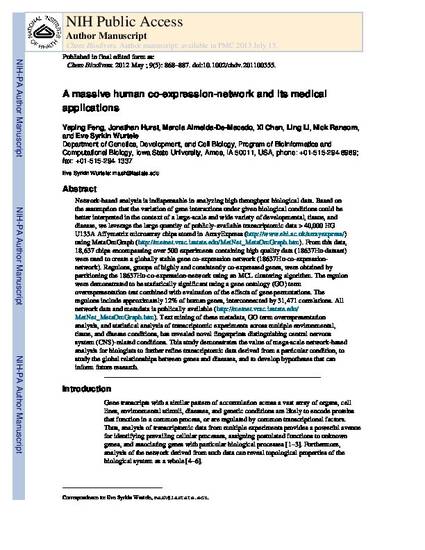
Article
A massive human co-expression-network and its medical applications
Chemistry & Biodiversity
Document Type
Article
Disciplines
Publication Version
Accepted Manuscript
Publication Date
5-1-2012
DOI
10.1002/cbdv.201100355
Abstract
Network-based analysis is indispensable in analyzing high throughput biological data. Based on the assumption that the variation of gene interactions under given biological conditions could be better interpreted in the context of a large-scale and wide variety of developmental, tissue, and disease, we leverage the large quantity of publicly-available transcriptomic data > 40,000 HG U133A Affymetrix microarray chips stored in ArrayExpress (http://www.ebi.ac.uk/arrayexpress/) using MetaOmGraph (http://metnet.vrac.iastate.edu/MetNet_MetaOmGraph.htm). From this data, 18,637 chips encompassing over 500 experiments containing high quality data (18637Hu-dataset) were used to create a globally stable gene co-expression network (18637Hu-co-expressionnetwork). Regulons, groups of highly and consistently co-expressed genes, were obtained by partitioning the 18637Hu-co-expression-network using an MCL clustering algorithm. The regulon were demonstrated to be statistically significant using a gene ontology (GO) term overrepresentation test combined with evaluation of the effects of gene permutations. The regulons include approximately 12% of human genes, interconnected by 31,471 correlations. All network data and metadata is publically available (http://metnet.vrac.iastate.edu/ MetNet_MetaOmGraph.htm). Text mining of these metadata, GO term overrepresentation analysis, and statistical analysis of transcriptomic experiments across multiple environmental, tissue, and disease conditions, has revealed novel fingerprints distinguishing central nervous system (CNS)-related conditions. This study demonstrates the value of mega-scale network-based analysis for biologists to further refine transcriptomic data derived from a particular condition, to study the global relationships between genes and diseases, and to develop hypotheses that can inform future research.
Copyright Owner
Verlag Helvetica Chimica Acta AG, Zürich
Copyright Date
2012
Language
en
File Format
application/pdf
Citation Information
Yaping Feng, Jonathan Hurst, Marcia Almeida-De-Macedo, Xi Chen, et al.. "A massive human co-expression-network and its medical applications" Chemistry & Biodiversity Vol. 9 Iss. 5 (2012) p. 868 - 887 Available at: http://works.bepress.com/eve-wurtele/52/

This is the peer reviewed version of the following article: Feng, Y., Hurst, J., Almeida-De-Macedo, M., Chen, X., Li, L., Ransom, N. and Wurtele, E. S. (2012), Massive Human Co-Expression Network and Its Medical Applications. Chemistry & Biodiversity, 9: 868–887, which has been published in final form at doi:10.1002/cbdv.201100355. This article may be used for non-commercial purposes in accordance With Wiley Terms and Conditions for self-archiving.